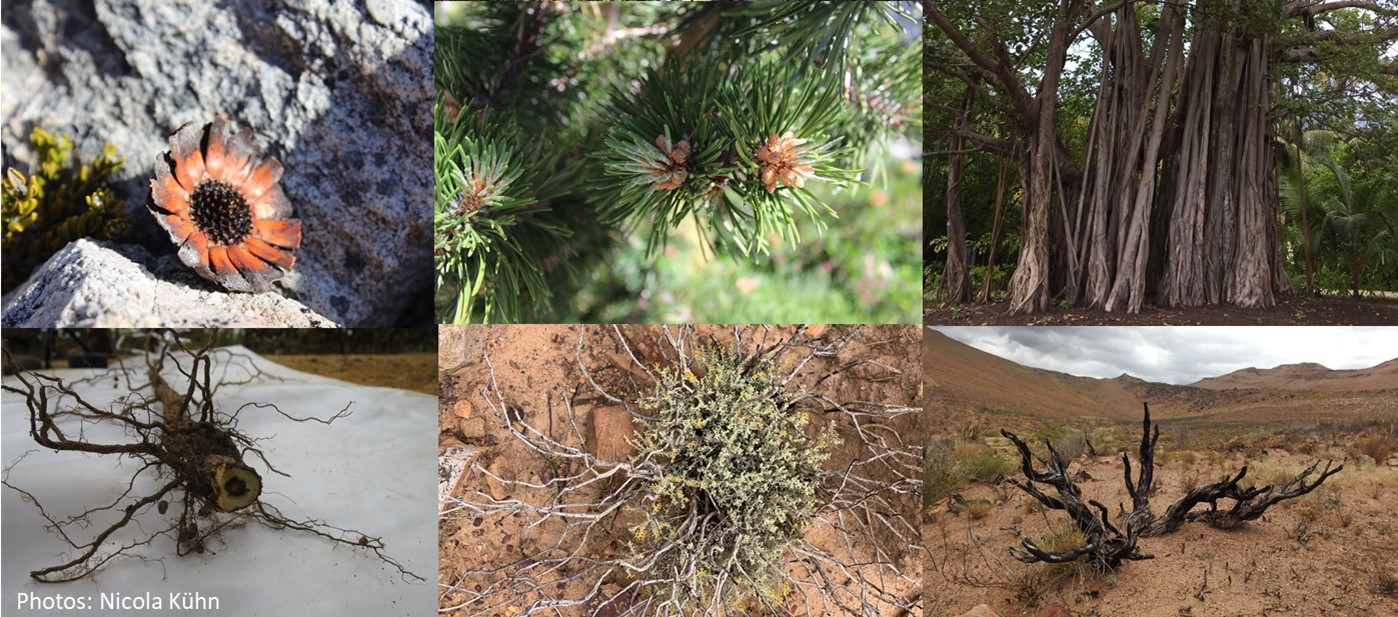Globally important plant functional traits for coping with climate change
December 1, 2021
“Look closely at nature. Every species is a masterpiece, exquisitely adapted to the particular environment in which it has survived.” E.O.Wilson
From the early Greek philosophical musings of Empedocles and Aristotle in the 4th and 5th century B.C., through the naturalist accounts of Darwin and Wallace more than 14 centuries later, right up to the present-day wealth of ecological studies fighting for their place in a scientific journal, plant and animal adaptations to their environments have continued to fascinate us. We are however, at a point in history where the knowledge of these characteristics or traits that allow organisms to persist and possibly thrive under harsh conditions is shifting from the interesting to the essential.
Trait-based ecological studies utilise the concept of ecological filtering, where plants with suitable traits can survive a set of climatic and environmental constraints and those that do not, are filtered out of the environment. Trait information thus holds a key piece of the puzzle in determining how organisms will respond to the pervasive and fast-paced anthropogenic climate change that we are facing.
In our recently published study in Frontiers of Biogeography (Kühn et al. 2021), we therefore asked: Is there a set of global traits that allow plants to cope with or even thrive under climate changes across biomes? To address this, we did a systematic global review of literature on the topic. We identified 148 studies that demonstrated a link between traits and positive plant responses in performance and fitness, to multiple climate changes and associated environmental changes.
Eight key traits appeared to best predict positive plant responses to multiple climate/environmental changes across biomes: lower or higher specific leaf area (SLA), lower or higher plant height, greater water-use efficiency (WUE), greater resprouting ability, lower relative growth rate, greater clonality/bud banks/below-ground storage, higher wood density, and greater rooting depth. Trait attributes associated with positive responses appeared relatively consistent within biomes and climate/environmental changes, except for SLA and plant height, where both lower and higher trait attributes are associated with a positive response depending on the biome and climate/environmental change considered.
 Research often focuses on the vulnerability of species to climate change, whereas our study offers an understanding of which traits may allow species to avoid the negative impacts of climate change. Our findings illustrate important and general trait-climate responses within and between biomes which can ultimately help us to understand which types of plants may cope with or thrive under current and future climate change. This knowledge is key when developing a range of management decisions. For instance, it could help crop breeding programs select species or varieties with key traits and trait attributes to cope with predicted future climate change. It could also help conservation and restoration actions to identify species that are resistant vs. vulnerable to climatic changes. Our analysis also has implications for which ecosystem services will be more resilient to climate change, as many are linked to specific traits (e.g., the size and architecture of root and shoot systems regulate climate, water, and soils of ecosystems). From our work we therefore conclude that a better understanding of traits and their relationships to climate and associated environmental changes is a key tool in the toolkit for ensuring more resilient ecological and agricultural systems.
Research often focuses on the vulnerability of species to climate change, whereas our study offers an understanding of which traits may allow species to avoid the negative impacts of climate change. Our findings illustrate important and general trait-climate responses within and between biomes which can ultimately help us to understand which types of plants may cope with or thrive under current and future climate change. This knowledge is key when developing a range of management decisions. For instance, it could help crop breeding programs select species or varieties with key traits and trait attributes to cope with predicted future climate change. It could also help conservation and restoration actions to identify species that are resistant vs. vulnerable to climatic changes. Our analysis also has implications for which ecosystem services will be more resilient to climate change, as many are linked to specific traits (e.g., the size and architecture of root and shoot systems regulate climate, water, and soils of ecosystems). From our work we therefore conclude that a better understanding of traits and their relationships to climate and associated environmental changes is a key tool in the toolkit for ensuring more resilient ecological and agricultural systems.
Also on the Blog...
Globally important plant functional traits for coping with climate change
By Nicola Kühn on December 1, 2021

“Look closely at nature. Every species is a masterpiece, exquisitely adapted to the particular environment in which it has survived.” E.O.Wilson From the early Greek philosophical musings of Empedocles and Aristotle ... Continue reading
The value of systematic evidence synthesis for land use decision-making and practice
By Dr Gillian Petrokofsky on November 9, 2021
Systematic evidence syntheses were adopted in environmental management and conservation in 2006 “to promote and deliver evidence syntheses on issues of greatest concern to environmental policy and practice as a ... Continue reading
Do flying cows have to pay a carbon offset?
By Professor Katherine J. Willis on October 26, 2021
Last week I learnt an interesting fact relating to carbon offsets when flying – if you fly business class you need to pay x 2.5 more carbon offset because of ... Continue reading
Ancient Plants, New Approaches
By Anna Lee-Jones on September 29, 2021
Encased within the unique Ryhnie Chert fossil system are some of the best-preserved early land plants in the world. Using pioneering digital technologies, we were able to reveal the developmental ... Continue reading
The Spanish Conquest & the Forests of Guatemala.
By Dr. William J. Harvey on July 12, 2021
Following the Spanish conquest of the territory that is now modern Guatemala (1524–1541 CE), the anthropogenic use of land use was radically transformed to support livestock husbandry, agriculture, large-scale timber extraction, mining, ... Continue reading
